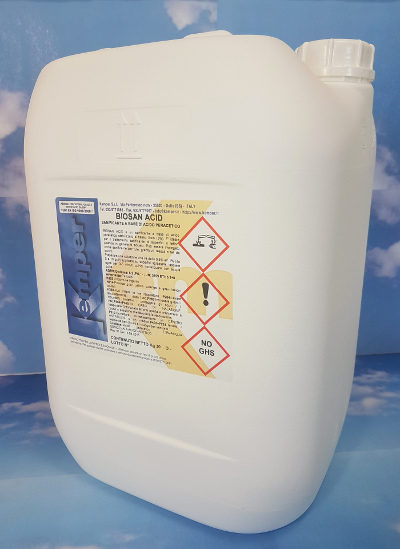FEATURES PDF
BIOSAN ACID is a biocide under registration (Case Number: SM-APP - BC-FP034061-47) for classes:
- PT 4 : Food & Feed Area
- PT 3 : Veterinary hygiene
based on stabilized peracetic acid and hydrogen peroxide.
The mechanism of action of the peracetic leads to the release of oxygen that is able to cross the protective barriers of microorganisms and destroy the cellular enzymes.
It shows a broad spectrum of action and is active on: Gram +, Gram-, Eumycetes and AAR bacteria.
Residues released from decomposition are completely biodegradable and non toxic.
This feature offers a double advantage (especially for the food industries): it doesn’t disturb the biological activity of the purifiers and after a time evaluable in some hours beyond the contact time of the BIOSAN ACID solutions on the equipment being treated, no residues are found.
Il prodotto è idoneo all’inserimento nei protocolli di sanificazione ambientale dei punti critici del piano HACCP, compresi gli impianti CIP (Cleaning in Place).
Ideal for the food industry: slaughterhouses, sausage factories, ham factories, pasta factories, winemaking and beverage industries, dairies, confectionery industries, and zootechnical breeding. The BIOSAN ACID can be used as a sanitizer for suits, aprons, fabrics and work towels.
The characteristics of the product also make it effective in environmental deodorizing and discoloration of various types of pigmented residues.
CHEMICAL/PHYSICAL DATA
Aspect: Limpid liquid
Color: Colorless
Odor: Pungent
Density (20°C): 1.15+/-0.05
Autodecomposition: > 60°C
Active principle: 5.5%
HOW TO USE
- Before sanitizing it is necessary to degrease and rinse thoroughly.
- Prepare an aqueous solution at 0.5-3% (5 -30 gr / l) according to the needs;
- Treat the degreased surfaces by wetting them completely and leave for 5 to 15 minutes.
- The temperature can be increased up to 40 ° C to increase the effectiveness of the solutions.
- If it deemed necessary to rinse, preferably with hot water.
WARNINGS: all aqueous solutions must be freshly prepared and used during the day.
The application on copper, bronze and brass parts isn’t recommended. Aluminum alloys must be verified. PTFE (Teflon), PVDF, PP, PE plastics are compatible as well as glass. Nitrile (NBR) and neoprene rubber have limited compatibility.
It is necessary to verify that the content of chloride ions (Cl-) in the water used for the preparation of BIOSAN ACID solutions doesn’t exceed 25 ppm (mg / l) in order to avoid the triggering of corrosive phenomena in particular on steels .
|
Indicative times, expressed in minutes, for the destruction of the target species. |
|||||||||
|
Work temperature |
5°C |
10°C |
20°C |
40°C |
|||||
|
Conc. [ppm] |
100 |
250 |
100 |
250 |
100 |
250 |
100 |
250 |
|
|
Gram + |
Staph. aureus |
5 |
3 |
3 |
2 |
2 |
1 |
1 |
0.5 |
|
Strept. Faecalis |
3 |
3 |
3 |
2 |
2 |
1 |
1 |
0.5 |
|
|
Gram - |
Aerobacter aerogenes |
1 |
1 |
1 |
1 |
1 |
1 |
1 |
0.5 |
|
Pseudom. aeruginosa |
3 |
1 |
2 |
1 |
1 |
0.5 |
1 |
0.5 |
|
|
Salmonella types |
3 |
2 |
3 |
2 |
2 |
2 |
1 |
1 |
|
|
Fungi |
Sacch. cerevisiae |
20 |
10 |
10 |
5 |
3 |
1 |
1 |
0.5 |
|
Cand. mycoderma |
120 |
40 |
90 |
40 |
40 |
10 |
3 |
1 |
|
|
Molds |
Penicillium camerunese |
>120 |
90 |
>120 |
90 |
20 |
10 |
3 |
1 |
|
Asp. Niger |
>240 |
>240 |
>240 |
>240 |
90 |
60 |
10 |
5 |
|
|
Mucor. Spec. |
>240 |
>240 |
>240 |
>240 |
20 |
5 |
3 |
1 |
|
|
Conc. [ppm] |
250 |
500 |
250 |
500 |
250 |
500 |
250 |
500 |
|
|
Spore |
Bac. cereus |
>60 |
>60 |
>60 |
>60 |
>60 |
60 |
40 |
10 |
|
Bac. subtilis |
>60 |
>60 |
>60 |
>60 |
>60 |
60 |
40 |
10 |
|
|
Bac. mesentericus |
>60 |
40 |
>60 |
40 |
10 |
5 |
10 |
1 |
|
|
Thermos. Sporulators |
>60 |
40 |
40 |
40 |
20 |
5 |
5 |
2 |
|
|
Clostridium perfrig. |
>60 |
10 |
>60 |
10 |
20 |
5 |
2 |
1 |
|
